
Juncaceae is a family of flowering plants, commonly known as the rush family. It consists of 8 genera and about 464 known species of slow-growing, rhizomatous, herbaceous monocotyledonous plants that may superficially resemble grasses and sedges. They often grow on infertile soils in a wide range of moisture conditions. The best-known and largest genus is Juncus. Most of the Juncus species grow exclusively in wetland habitats. A few rushes, such as Juncus bufonius are annuals, but most are perennials.

Juncus articulatus is a flowering plant species in the rush family Juncaceae. It is known by the common name jointleaf rush or jointed rush, which can also refer to J. kraussii from Australia. It is native to Eurasia, Canada, Greenland, and much of the United States. It grows in moist areas, such as wet sand, and thrives in calcareous soils. J. articulatus was found to be more sensitive to drought and salt stress than its congeners J. acutus and J. maritimus. It is a perennial herb producing mainly erect stems from a short rhizome. The stem may root at nodes, and it generally has one or more flattened hollow cylindrical leaves up to 10 centimeters long. Transverse internal partitions or joints may be seen or felt in the leaf of the plant.
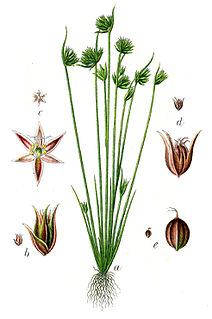
Juncus capitatus is a species of rush known by the common names dwarf rush and leafybract dwarf rush. It is native to Europe, Asia and North Africa. It is also an introduced species in parts of North America such as California and the Gulf Coast. It grows in moist areas, such as wet sand, vernal pools, and ditches.
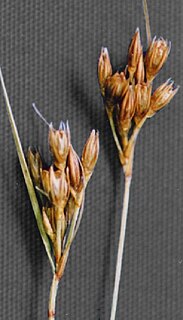
Juncus confusus is a species of rush known by the common name Colorado rush. It is native to western North America from British Columbia to northern California to Colorado, where it grows in coniferous forests and wet, grassy areas such as mountain meadows. It is a bunching rhizomatous perennial herb which grows to a maximum height between 30 and 50 centimeters. Its thready leaves grow from the base of the light green stems to about 15 centimeters long. The inflorescence atop the stem is an array of individual flowers and there is a long bract at the base which may be up to 8 centimeters in length. Each flower has long, pointed tepals with dark and light longitudinal stripes and membranous, translucent borders. There are six stamens. The fruit is a light to dark brown oval-shaped or rounded capsule.
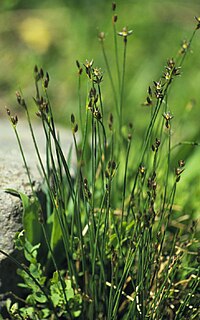
Juncus drummondii is a species of rush known by the common name Drummond's rush. It is native to western North America from northern Canada and Alaska to New Mexico, where it grows in wet coniferous forest and alpine meadows and slopes. This is a perennial herb forming narrow, erect tufts to about 40 centimeters in maximum height. The leaves are basal and most have no real blades; instead they form a sheath around the stem a few centimeters long. The inflorescence is borne on the side of the stem toward the top. There is a long, cylindrical bract at the base which extends out past the flowers. Each flower is on a thin pedicel. The thick tepals are dark brown, sometimes with green striping and thin, transparent edges. There are six stamens with yellowish anthers, and red stigmas. The fruit is a capsule.

Juncus mertensianus is a species of rush known by the common name Mertens' rush or Alaska rush. It is native to much of western North America from Alaska to Saskatchewan to New Mexico, where it grows in wet mountainous areas such as riverbanks and alpine meadows. This is a clumping perennial herb growing from a vertical rhizome. Its smooth, flat stems grow to a maximum height near 40 centimeters. Its few leaves are located at the base and also along the stem. The inflorescence is made up of usually one cluster of many flowers. Each flower has shiny dark brown to black tepals 3 to 4 millimeters long, six stamens with yellowish anthers, and long reddish stigmas, as in image at left. The fruit is a dark, oblong capsule, as in image at right.
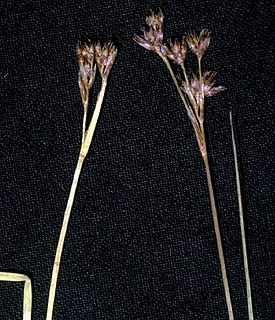
Juncus nevadensis is a species of rush known by the common name Sierra rush. It is native to much of western North America from British Columbia to New Mexico, where it grows in wet areas in many habitat types. This is a rhizomatous perennial herb which varies in appearance. Its thin, smooth stems reach a maximum height between 10 and 70 centimeters. The thin green leaves may be up to 30 centimeters long. The inflorescences generally contain a number of flowers, with each flower bearing dark to very light brown tepals, six stamens with large anthers, and very long stigmas. The fruit is a shiny chestnut brown capsule.
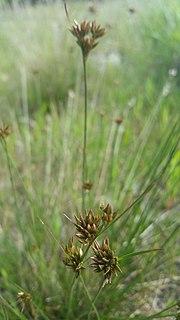
Juncus occidentalis is a species of rush known by the common name western rush. It is native to the western United States, where it grows in wet areas in many types of habitat. This is a bunching perennial herb with thin, stiff stems reaching maximum heights between 30 and 60 centimeters. The wispy leaves grow from the base of the stem and may approach half the stem's length. The inflorescence holds loose bundles of individual flowers and there is usually one long, leaflike bract extending far past the flowers. Each flower has green-striped brownish to reddish tepals each several millimeters long, and six stamens with small anthers. The fruit is a brown capsule which grows encased within the tepals.
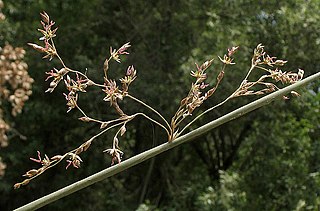
Juncus textilis is a species of rush known by the common name basket rush. It is endemic to California, where it grows along the coast and in the coastal mountain ranges of the southern half of the state.
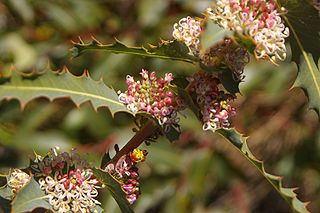
Hakea amplexicaulis, commonly known as prickly hakea, is a shrub endemic to south west Western Australia. An attractive small shrub with unusual stem clasping, sharply serrated foliage and a profusion of sweetly scented variable coloured flowers from late winter to spring.

Juncus bolanderi is a species of rush known by the common name Bolander's rush. It is native to western North America from British Columbia to northern California, where it grows in many types of wet habitat, such as marshes, beaches, and meadows. It is a rhizomatous perennial herb forming bunches of smooth stems up to about 80 centimeters long. The inflorescence is made up of one or more clusters of many tiny flowers accompanied by one long bract. Each flower has brown, pointed segments each about 3 millimeters long.
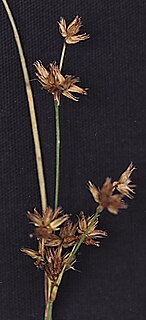
Juncus nodosus is a species of rush known by the common name knotted rush. It is native to much of North America from northern Canada to central Mexico, where it grows in wet places from freshwater to salt marsh habitat. This is a rhizomatous perennial herb producing slender, smooth stems up to about 60 centimeters tall. The inflorescence is a series of spherical clusters of flowers. Each flower has green or brown pointed segments each a few millimeters long and tapering to a point.
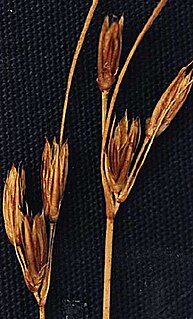
Juncus parryi is a species of rush known by the common name Parry's rush. It is native to western North America from British Columbia and Alberta to California to Colorado, where it grows in moist and dry spots in mountain habitat, including rocky talus and other areas in the subalpine and alpine climate. This is a rhizomatous perennial herb producing a dense clump of stems up to about 30 centimeters tall. There are short, thready leaves around the stem bases. The inflorescence is a cluster of flowers accompanied by a long, cylindrical bract which appears like an extension of the stem. The flower is made up of a few pointed, brown segments with membranous edges.
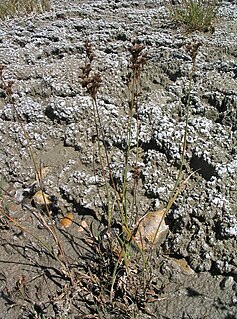
Juncus saximontanus is a species of rush known by the common name Rocky Mountain rush. It is native to much of western North America from Alaska to central Mexico, where it grows in wet habitat, often in mountainous areas, such as bogs and moist meadows.
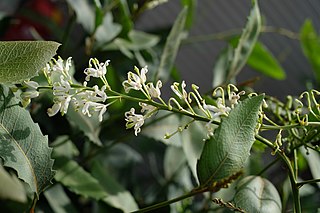
Lomatia ilicifolia, commonly known as holly lomatia or native holly, is a plant in the family Proteaceae and is endemic to south-eastern Australia. It is a stiff, erect shrub with hairy, rust-coloured new growth and which recovers from fire from a lignotuber. It has dull green, leathery, prickly, holly-like leaves and long sprays of cream flowers, usually after fire.
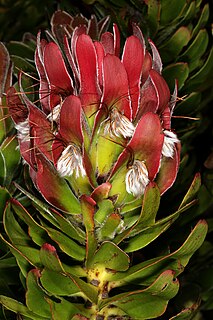
Mimetes fimbriifolius, also called cowl pagoda or the fringed pagoda, is a species of plant in the family Proteaceae. It is a dense, rounded, multi-branched tree that grows up to 4 metres in height. This attractive and striking plant flowers all year round, and produces red and yellow branch-heads and inflorescences. The nectar-rich flowers are pollinated by sunbirds and the seeds are distributed and taken underground by ants before germinating. It is endemic to the Table Mountain range in the city of Cape Town, South Africa.

Juncus acutiflorus, also called sharp-flowered rush, is a rush or a grassy plant of the genus Juncus. As the name suggests, the plant has notable sharp-looking flowers, flowering between July and September.
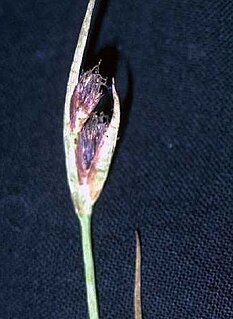
Juncus castaneus is a species of rush known by the common name chestnut rush. It has a circumboreal or circumpolar distribution, occurring throughout the northern latitudes of the Northern Hemisphere. It occurs in Europe, Asia, and North America. In North America it occurs from Alaska to Greenland, its distribution spanning Canada and extending south through the Rocky Mountains in the contiguous United States. It is widespread and common in the Canadian Arctic Archipelago.
Luzula wahlenbergii, commonly known as Wahlenberg's woodrush or reindeer wood-rush, is a perennial species of plant in the genus Luzula of the (rush) family Juncaceae.

Schoenoplectus lacustris, the lakeshore bulrush or common club-rush, is a species of club-rush that grows in fresh water across Europe and some neighbouring areas.



















